Popular Content
Want Email Updates?
Get emails about new stuff.
Be the first to know.
Looking for Something?
Poetic Devices
Page Navigation
Alliteration
Repeating the same first consonant sounds in a series of words
Alliteration is the repetition of the initial consonant sound in words. An easier (though less exact) way to say this is that alliteration is when the first sounds in words repeat. Alliteration often works with assonance and consonance to make phonetically pleasing arrangements.
Jakia jumped in the jar of jelly.
Despite their mother's warnings, the children chose to chew with their mouths open.
The grass grew green in the graveyard.
Notice the repetition of the "j" sound in the first example? Alliteration is not always so jarringly obvious. Sometimes it is subtle, such as in the following example:
He keeps the kitchen clean.
This example shows that even when one word starts with a "k" and another word starts with a "c," it is still considered an instance of alliteration. When we study alliteration, we are concerned with the sounds of the words, not just the letters.
Assonance
Repeating vowel sounds in a series of words
Assonance is the repetition of vowel sounds. It is often used in combination with consonance and alliteration to create sound patterns that are near rhymes.
He saw the cost and hauled off.
Will she read these cheap leaflets.
The snow in the grove froze.
Notice the repetition of the "awe" sounds in the first example, the "e" sounds in the second example, or the "o" sounds in the third example? Assonance can be subtle and may go unnoticed if you're not scanning for it.
Consonance
Repeating consonant sounds at the end or middle of words
Consonance creates cool sound patterns. When used with assonance, it can create off rhymes or slant rhymes. Consonance is the repetition of consonant sounds in the middle or at the end of series of words. Using consonance is a sophisticated poetic technique that can create subtle yet beautiful lyrics or lines of poetry. Here is an example of consonance:
Her finger hungered for the ring.
The satin mittens were ancient.
You could paddle through the spittle in the bottle.
The first of the above is also an example of personification, but we are more interested in the sounds here. Consonance is something that we hear with our ears. In that example we hear the repetition of the "nger" and "ng" sounds. If nobody is around you right now, say out loud, "hungry and angry." Notice how similar the words sound? What you are hearing is consonance, or the repetition of the "ngry" consonant sounds.
Enjambment
Using line breaks for emphasis or effect
Enjambment is when the writer uses line breaks meaningfully and abruptly to either emphasize a point or to create dual meanings. When reading a poem, speakers should make a slight pause (shorter than a comma) when transitioning from line to line. When a writer uses enjambment, he or she uses this space to spread an idea over more than one line. This may create an alternate interpretation of the lines. Or it may draw attention to the enjambed words. Here is an example:
Rolling through the field in the
dead
of winter.
When the word dead is placed on a line in isolation, it invites the reader to focus on that idea. Surrounded by empty space, the idea may resonate powerfully. Many poets use the space on the page in meaningful ways. Enjambment is a cool technique to practice doing this. Try using it in the next poem that you write.
dead
of winter.
Imagery
Descriptions that use the senses
Imagery is writing or speech that accesses the senses of the audience. By senses, I mean the five senses that we use to experience the physical world: sight, hearing, taste, touch, and smell. This is also called using sensory details. Here are some examples of imagery:
An old lump of snow melted in the corner.
The chirping crickets filled the empty night air.
I was awoken by the pleasing scent of the bacon as it wafted down the hallway.
As you read the first example, you might be visualize snow melting. This description accesses your sense of sight. When you read the second example, you may imagine the noises that crickets make. The imagery in the text references this sound. And as you encounter the third example, you may recall the aroma of bacon. These examples all access different senses. Imagery helps writers and speakers SHOW readers things. Good writers don't just tell readers things, they show the reader by using imagery.
Repetition
Using a word or group of words more than once for effect
Repetition is when the writer or speaker knowingly repeats a word or group of words. This is a strong rhetorical technique that can also be used to build a theme in a speech or poem. It is not considered repetition when a writer or speaker repeats little words like a or the. Repetition is used intentionally.
Nobody, oh nobody can make it out here alone.
Free at last! Free at last! Thank God Almighty, we are free at last!
Love is a red, red rose.
In the first example, only one word in the sentence is repeating: nobody. In the second example a whole group of words repeats: Free at last. A poet may repeat a single word, a group of words, or entire lines and stanzas. Repetition may give a word or phrase greater impact. Or it may highlight the importance of an idea. Repetition can embolden a message.
Rhyme
Grouping words that share the same ending sound
Rhyme is when the end or final sound of two or more words are identical and the words are used together. If the end sounds are not identical, then the speaker or writer may be using consonance or assonance instead.
We often think rhyme is something used at the end of lines. This is true. But rhymes can also be used internally, on the inside of words or lines of poetry.
Rhymes may be monosyllabic (a one syllable) or polysyllabic (two or more syllables). such as in the following examples:
I left my punch card on the lunch yard.
I drove a race car to the space bar.
We saw a butter fly flutter by.
This is the technique that students most often associate with poetry. Many students think poems NEED to rhyme. But I encourage my students to try writing free or blank verse. Poetry is about expression and the beauty of language. Rhyming is fun but poems don't need to rhyme.
Rhythm
Arranging words to make a sound pattern that repeats
Rhythm is when words are arranged to create an audible pattern or beat when read out loud. A good way to check if a text has rhythm is to hum the sounds that the words make rather than clearly pronouncing them. If you can hear a song or identify a form in the sounds, then the text has rhythm.
There once was a guy from Chicago / Who ran away from all his problems.
I know it is wet and the sun is not sunny / but we can have lots of good fun that is funny.
Shall I compare thee to a summer's day?
Instead of just reading these examples, trying humming them. Do you hear how they sort of bounce? This is a rhythm.
Poetic Devices Video Game
Poetry Cat: Poetic Devices Video Game
This is a fun and free browser game to help you review poetic devices. Students play as a cat and try to collect balls of yarn. When they get hit by an enemy, they have to answer a question to proceed. This game is fun, engaging, and has hundreds of questions on poetic devices. Very educational!
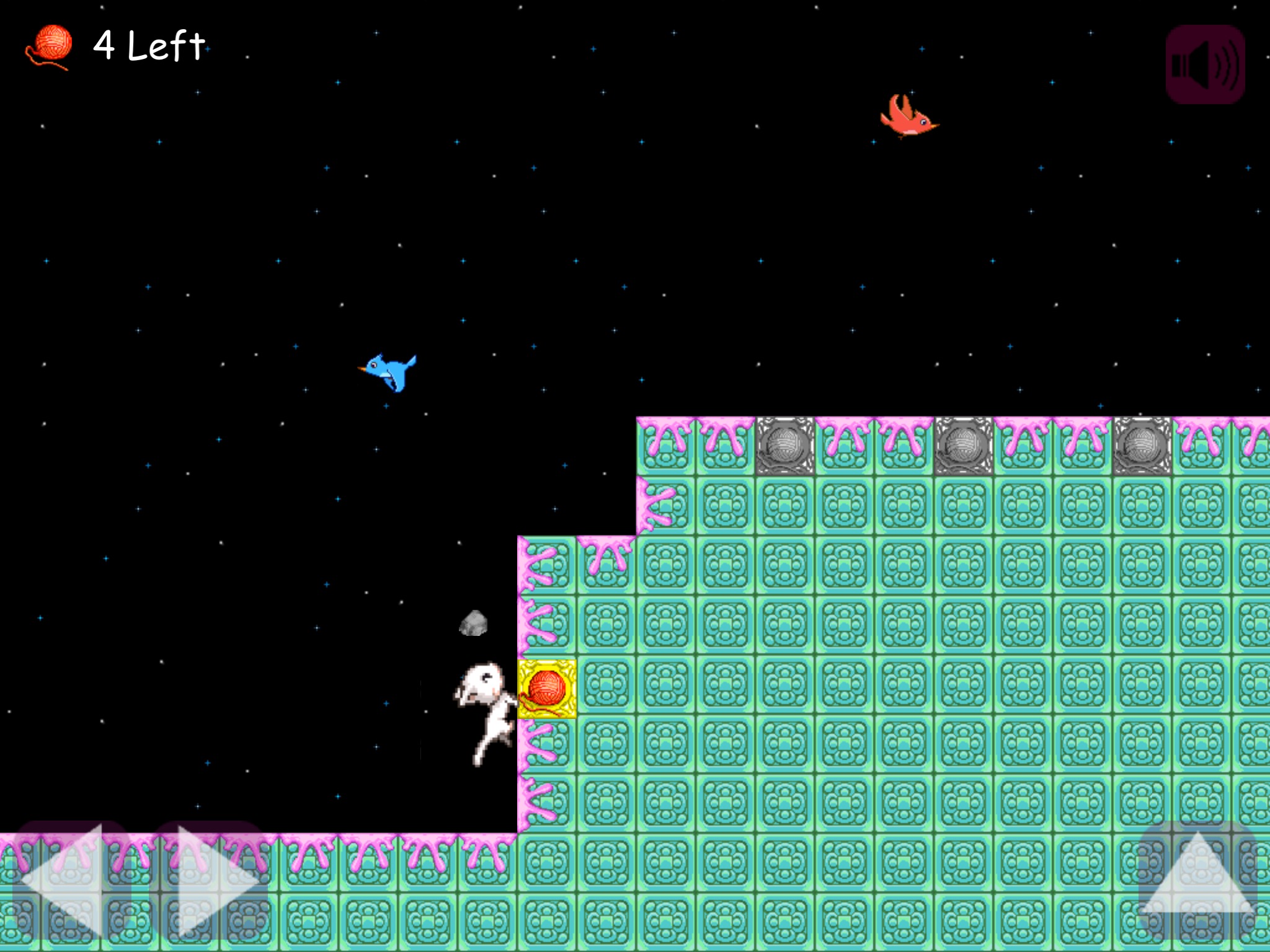
Poetic Devices Worksheets
Poetic Devices Worksheet 1
Here are 10 problems to give you or your students practice with poetic devices. Read the poetry snippets, identify two or more poetic devices in use, and explain your answer.
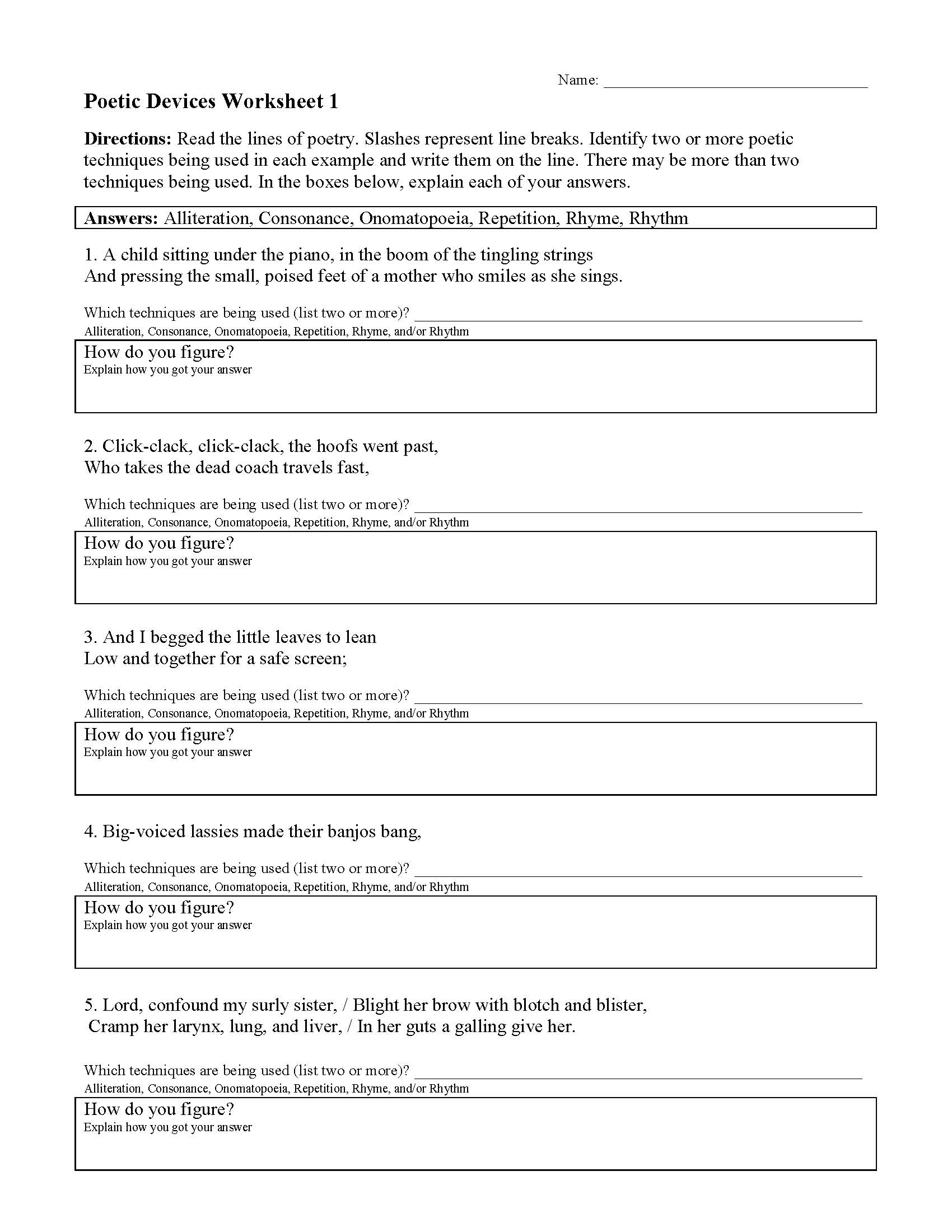
Poetic Devices Worksheet 2
Here is another poetic devices worksheet. This one is five-pages with 26 practice problems. Read the poetry snippets, identify the poetic devices, and explain your answers.
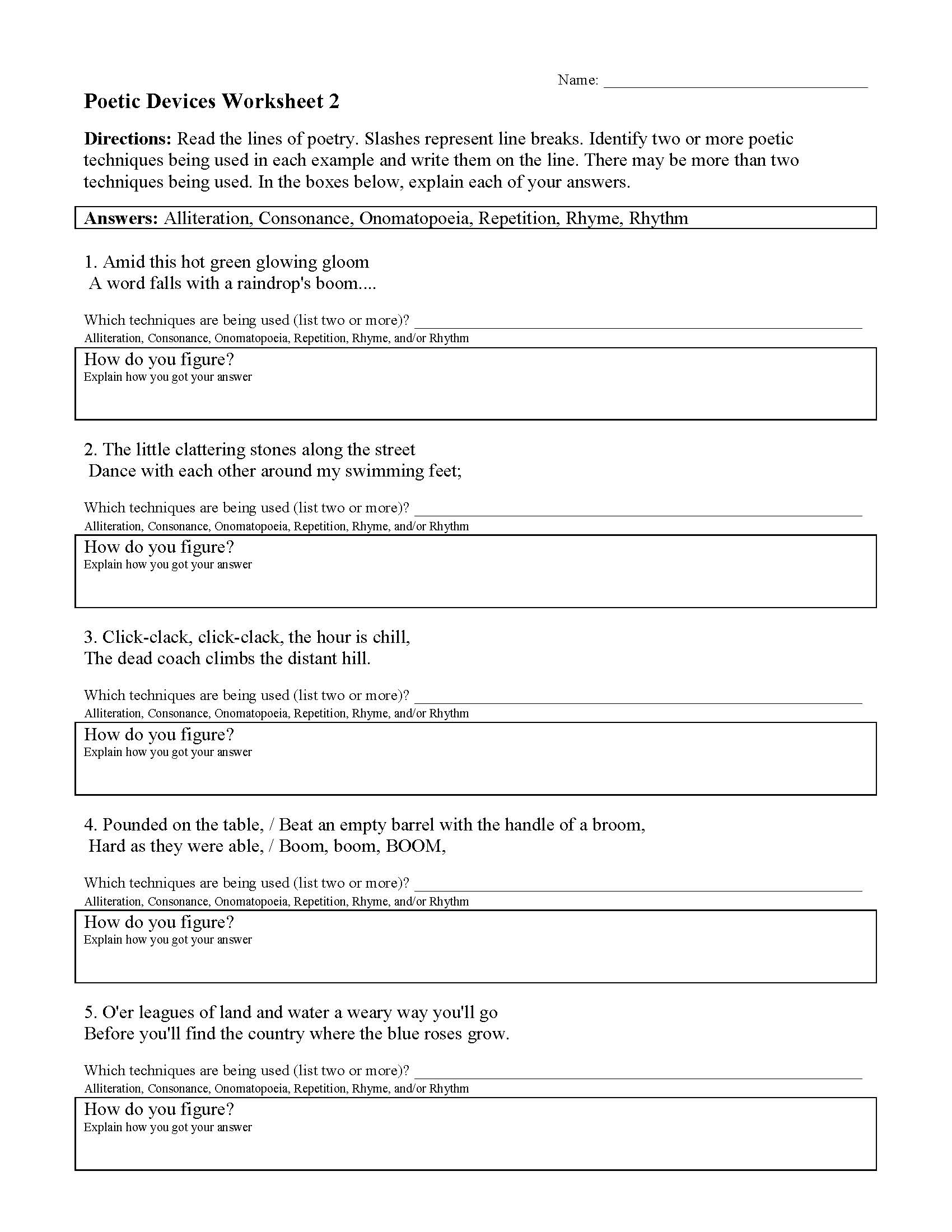
Poetic Devices Activities
Poetic Devices Lesson 1
Here is a PowerPoint slideshow lesson on poetic devices. It teaches students about the sounds of poetry: onomatopoeia, rhythm, rhyme, repetition, alliteration, and consonance. It also includes ten practice problems after the lesson. These are great skills to teach while appreciating poetry.

Figurative Language
Common Core State Standards
Figurative Language Anchor Standards
R.4 - Interpret words and phrases as they are used in a text, including determining technical, connotative, and figurative meanings, and analyze how specific word choices shape meaning or tone.RL.2.4 - Describe how words and phrases (e.g., regular beats, alliteration, rhymes, repeated lines) supply rhythm and meaning in a story, poem, or song.
RL.3.4 - Determine the meaning of words and phrases as they are used in a text, distinguishing literal from nonliteral language.
RL.4.4 - Determine the meaning of words and phrases as they are used in a text, including those that allude to significant characters found in mythology (e.g., Herculean).
RL.5.4 - Determine the meaning of words and phrases as they are used in a text, including figurative language such as metaphors and similes.
RL.6.4 - Determine the meaning of words and phrases as they are used in a text, including figurative and connotative meanings; analyze the impact of a specific word choice on meaning and tone.
RL.7.4 - Determine the meaning of words and phrases as they are used in a text, including figurative and connotative meanings; analyze the impact of rhymes and other repetitions of sounds (e.g., alliteration) on a specific verse or stanza of a poem or section of a story or drama.
RL.8.4 - Determine the meaning of words and phrases as they are used in a text, including figurative and connotative meanings; analyze the impact of specific word choices on meaning and tone, including analogies or allusions to other texts.
RL.9-10.4 - Determine the meaning of words and phrases as they are used in the text, including figurative and connotative meanings; analyze the cumulative impact of specific word choices on meaning and tone (e.g., how the language evokes a sense of time and place; how it sets a formal or informal tone).
RL.11-12.4 - Determine the meaning of words and phrases as they are used in the text, including figurative and connotative meanings; analyze the impact of specific word choices on meaning and tone, including words with multiple meanings or language that is particularly fresh, engaging, or beautiful. (Include Shakespeare as well as other authors.)
Click to VIEW Grade Level Standards for R.4
L.5 - Demonstrate understanding of figurative language, word relationships, and nuances in word meanings.
L.3.5a - Distinguish the literal and nonliteral meanings of words and phrases in context (e.g., take steps).
L.4.5 - Demonstrate understanding of figurative language, word relationships, and nuances in word meanings.
L.4.5a - Explain the meaning of simple similes and metaphors (e.g., as pretty as a picture) in context.
L.5.5a - Interpret figurative language, including similes and metaphors, in context.
L.6.5 - Demonstrate understanding of figurative language, word relationships, and nuances in word meanings.
L.6.5a - Interpret figures of speech (e.g., personification) in context.
L.7.5 - Demonstrate understanding of figurative language, word relationships, and nuances in word meanings.
L.7.5a - Interpret figures of speech (e.g., literary, biblical, and mythological allusions) in context.
L.8.5 - Demonstrate understanding of figurative language, word relationships, and nuances in word meanings.
L.8.5a - Interpret figures of speech (e.g. verbal irony, puns) in context.
L.9-10.5 - Demonstrate understanding of figurative language, word relationships, and nuances in word meanings.
L.11-12.5 - Demonstrate understanding of figurative language, word relationships, and nuances in word meanings.
L.11-12.5a - Interpret figures of speech (e.g., hyperbole, paradox) in context and analyze their role in the text.
L.3.5a - Distinguish the literal and nonliteral meanings of words and phrases in context (e.g., take steps).
L.4.5 - Demonstrate understanding of figurative language, word relationships, and nuances in word meanings.
L.4.5a - Explain the meaning of simple similes and metaphors (e.g., as pretty as a picture) in context.
L.5.5a - Interpret figurative language, including similes and metaphors, in context.
L.6.5 - Demonstrate understanding of figurative language, word relationships, and nuances in word meanings.
L.6.5a - Interpret figures of speech (e.g., personification) in context.
L.7.5 - Demonstrate understanding of figurative language, word relationships, and nuances in word meanings.
L.7.5a - Interpret figures of speech (e.g., literary, biblical, and mythological allusions) in context.
L.8.5 - Demonstrate understanding of figurative language, word relationships, and nuances in word meanings.
L.8.5a - Interpret figures of speech (e.g. verbal irony, puns) in context.
L.9-10.5 - Demonstrate understanding of figurative language, word relationships, and nuances in word meanings.
L.11-12.5 - Demonstrate understanding of figurative language, word relationships, and nuances in word meanings.
L.11-12.5a - Interpret figures of speech (e.g., hyperbole, paradox) in context and analyze their role in the text.
Click to VIEW Grade Level Standards for L.5
Still looking for something?
Search here.
Search here.
Leave a comment
52 Comments
Leave a Reply
By Using This Website You Agree to the Terms of Use and are aware of our privacy policy.
Subscribe Now
Get emails about new stuff.
Don't worry. I hate spam too.
Some Other Useful Pages
- Author's Purpose Worksheets
- Characterization Worksheets
- Conflict Worksheets
- Fact and Opinion Worksheets
- Figurative Language Activities
- Figurative Language Poems with Questions
- Genre Activities
- Irony Worksheets
- Making Predictions
- Mood Worksheets
- Nonfiction Passages and Functional Texts
- Parts of Speech Worksheets
- Poetic Devices
- Point of View Worksheets
- School Project Ideas
- Setting Worksheets
- Simile and Metaphor Worksheets
- Story Structure Worksheets
- Text Structure Worksheets
- Theme Worksheets
- Tone Worksheets
- ALL PAGES AND WORKSHEETS
Search This Site

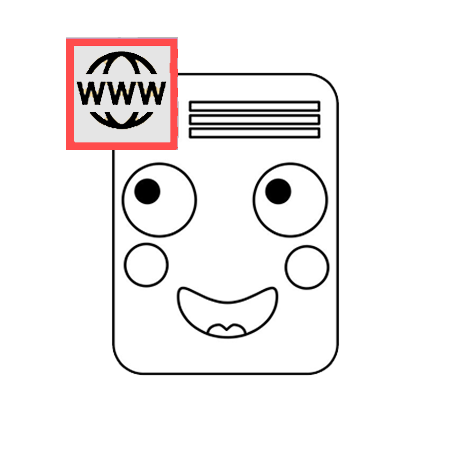


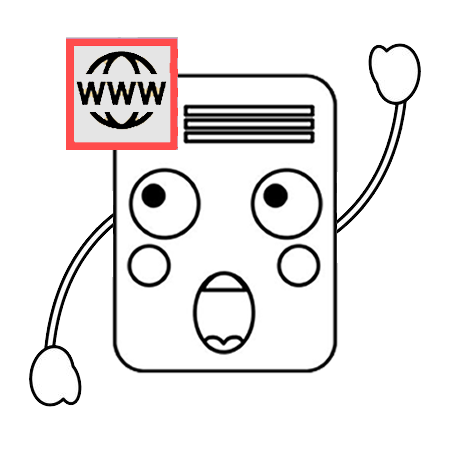


sharone
/ August 5, 2023tis is such a good website thank you sooo much
CAO YAN
/ June 29, 2023This website is great and the resources have been a life saver. Do you have anything on euphony, cacophony, sibilance etc.
Amarachi Blessing
/ April 19, 2023I will sincerely and whole heartedly say thanks for this website. You have been of great help to me more than you can ever know. Thank you.
James
/ June 26, 2021This website is a great resource. Thank you so much.
Mr. D
/ September 26, 2019My students are having an issue with level 4 on Poetry Cat. I think there might be a glitch.
Mr. Morton
/ September 26, 2019Hello. I just played through level 4. I didn’t experience any glitch. Maybe they just haven’t figured out that you have to HOLD UP on the springs to jump higher. Level 4 of Poetry Cat exists to teach players this functionality, which is important for later in the game. Level 4 will not let you complete it until they learn to superbounce on springs.
Unless you’re experiencing something else.
If so, please describe what is occurring.
Thanks for playing!
peninah
/ August 6, 2019so helpful thank you so much.
Pulkit Singh
/ July 19, 2019Please sir help me to identify clauses and phrases i can’t understand
Cool
/ December 5, 2016I am using this to learn for my exams. Thanks a lot!
Subha Poduval
/ October 24, 2016Very helpful site for teachers.Thank you
Ms. Marie
/ May 9, 2016Very helpful, thank you. Just the right examples and articulation I needed for my Year 8s. Bless U
Kaylyn Coleman
/ January 6, 2016I love this website! I use this all the time and it helped me with my finals thank you so much! I am hoping for more I had got an A on my finals. Thanks So Much!
Betsy
/ November 17, 2015Our whole language arts department depends heavily upon your wonderful website. We fight over which grade level gets to use which resources!
Mr. Morton
/ November 18, 2015How flattering. I am working toward a day when your department will have worksheets leveled for all grades. Thank you for your comment.
sayan
/ September 27, 2015thanxx helped me a lot in my english examintion it was really good of u!!!
(- _-)—
V. Diaz
/ March 26, 2015Thank you so much for sharing. I had a son that had doubts and had an exam tomorrow. We do not speak English and he doesn’t understand anything of this in English. Thanks to your work he could study and I got surprised when I realized that his English teacher used your examples too (ha). Blessings!
Mr. Morton
/ March 27, 2015I am touched by your comment. Thank you for taking the time to leave it. Best wishes now and in the future.
Fizza malik
/ February 8, 2015that was so amazing….it helps me alot preparing my English test… 🙂
jm
/ November 16, 2014thank you so much. Just needed these to explain how to use metaphors correctly
cheers
Earl Adrian
/ November 9, 2014Thank you very much! Because of you I passed my exams with flying colors!!! More power to you!!! 🙂
Gayaneh
/ March 30, 2014Thank you so much for the quizzes, I am going to use them in my course on stylistics and I find them very useful.
Mr. Morton
/ April 21, 2014Awesome.
I’ve got like 4 more worksheets to add to this page.
I’m going to do some big updates this summer.
Hermain Qadir
/ December 8, 2013Thank you! This has really helped me for my English exam 🙂 I think now I will visit this site more often as there is so much material to view.
Mr. Morton
/ December 18, 2013I look forward to your visits.
Linda
/ September 25, 2013thank you very much… so helpful…
Kimberly
/ June 4, 2013Thank you so much!!
Cheryl Rowe
/ April 4, 2013I really appreciate your worksheets with the common core emphasis that makes them explain. I would love to see something to teach etymology! Also something would be appreciated on the parts of plot: identifying exposition, rising action, climax, falling action and resolution in sample excerpts.
Mr. Morton
/ May 1, 2013Thank you for saying so. I will be adding the specific standards that each page addresses shortly. In the meantime, check these out:
http://www.ereadingworksheets.com/free-reading-worksheets/story-structure/story-structure-worksheets/
http://www.ereadingworksheets.com/free-reading-worksheets/story-structure/story-structure-activities/
😀
elizabeth
/ March 31, 2013Thank you, thank you. I have been writing poetry since grade one (about 74) years, and never knew how. Now I can edit and reword and feel proud of my work.
Send me what I need from step 1. om om (universal sound) e
Mr. Morton
/ May 1, 2013Wow! I’m sure that you’ve crafted some gems. Share them with the world.
mrs. poirier
/ March 13, 2013I don’t know who creates the lessons for this website, but I am immensely thankful for the great ideas and useful practice through the worksheets!!!
Mr. Morton
/ March 21, 2013Thank you for your appreciation. Best wishes!
Lis
/ March 8, 2013Your website is amazing and great for worksheets for students. THANK YOU SOOO MUCH
T. Griffin
/ February 18, 2013I really appreciate your time, hardwork and dedication. Thank you so much!!!!!!!!!!
Mr. Morton
/ March 3, 2013Thank you for saying so. Best wishes!
HEMALI PAREKH
/ February 15, 2013JUST KNOWLEGABLE, EXCELLENT, TOTAL PACK; THANKS ALOT TO THE CONCERNED.
E Rodriguez
/ January 16, 2013I have been searching for so long and everything I needed is so beautifully done here on your site. Thank you!
iklygn
/ January 13, 2013very nice
Meagan
/ November 30, 2012I’m an Aussie teacher and I love this site! I use it so often, especially the powerpoints as a source for many of my mini lessons. Then the accompanying worksheets are perfect for a short, sharp skill practising task.
I’ve shared this resource with many of my colleagues too. Thank you so much!
Dee
/ May 27, 2012Thank you for sharing your time and knowledge. Your web site is great! We need more people like you who share the knowledge! Thank you again. 🙂
Max Antonioni
/ May 8, 2012This website is amazing and it help me out loads. I had an English exam due in 2 days and I was studying for it and as soon as I found this website I knew I would pass! Thanks 🙂
Mrs. C Peterson
/ May 1, 2012LOVE this! Worked great for my kids. Thank you so much!
Yolanda
/ April 29, 2012I’m a first-year teacher and your worksheets are helping me a great deal. Thank you so much for sharing and caring!
Yolanda
Mr. Morton
/ May 3, 2012Thanks for visiting!
Jaina L. Paraiso
/ April 26, 2012Great resources we have here. Thank you very much for sharing.
J. Filemu
/ April 20, 2012Your worksheets and PowerPoint material are exactly what I need. Thank you!
J. Knapp
/ February 8, 2012Your worksheets are wonderfully done and much appreciated. Thank you so much!
Sharanda Payseur
/ December 15, 2011I absolutely love what you have collected here. It is exactly what I needed. Fantastic work! Thank you for sharing.
Mr. Morton
/ January 14, 2012It’s my pleasure. I have a couple more worksheets to add to this page, if I can ever get around to it…
Laurie Thompson
/ October 31, 2011I love your website. I was wondering if you would ever consider adding a few more to your website. Please consider the following: tone/mood, symbolism, analogy, and author’s viewpoint. Thanks in advance. You save me so much time with your great worksheets. 🙂
Mr. Morton
/ October 31, 2011Thanks for the suggestions. I believe I have those “author’s viewpoint” worksheets, but I’d love to get around to adding materials on those other topics. Thank you for visiting!